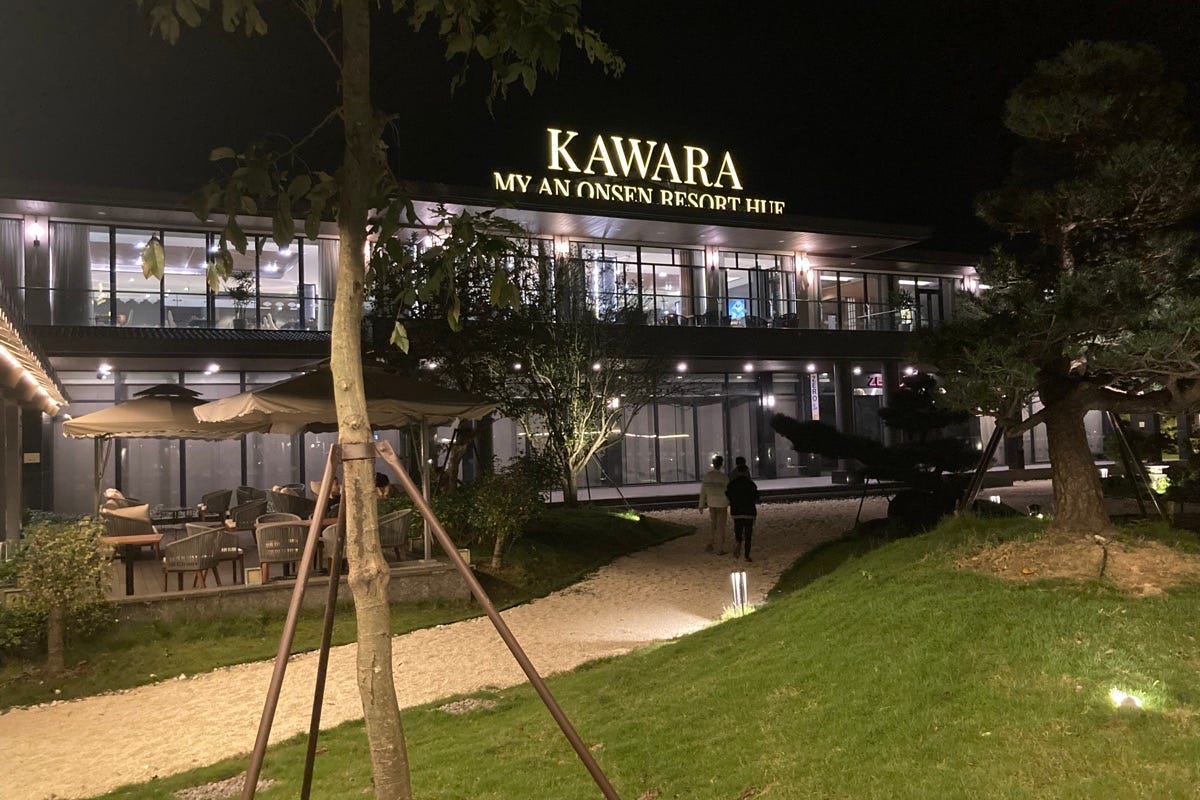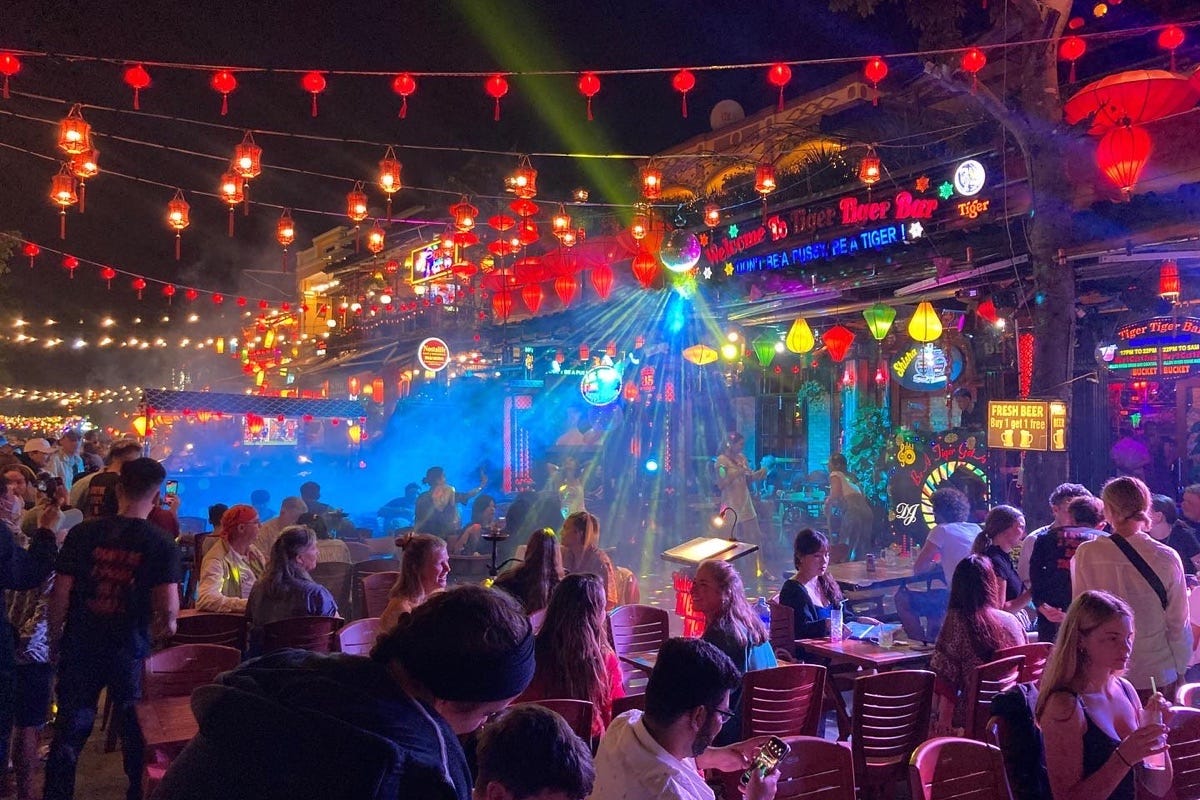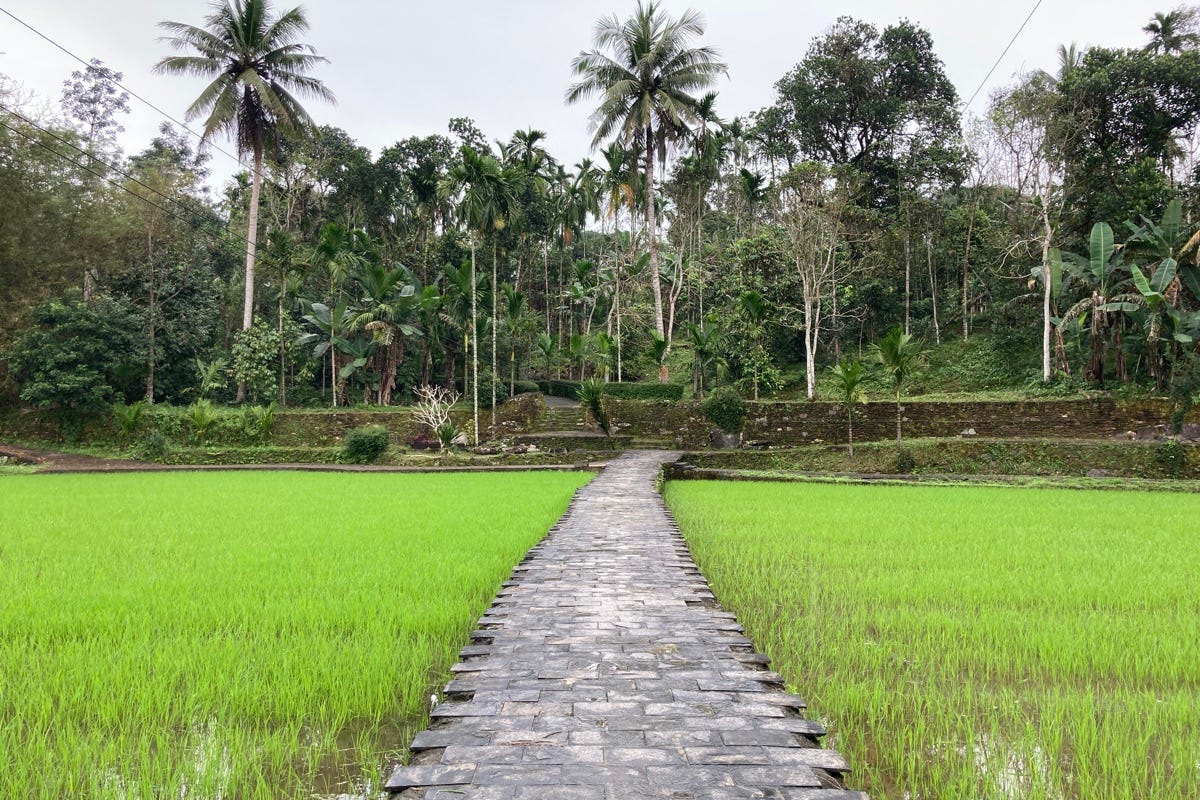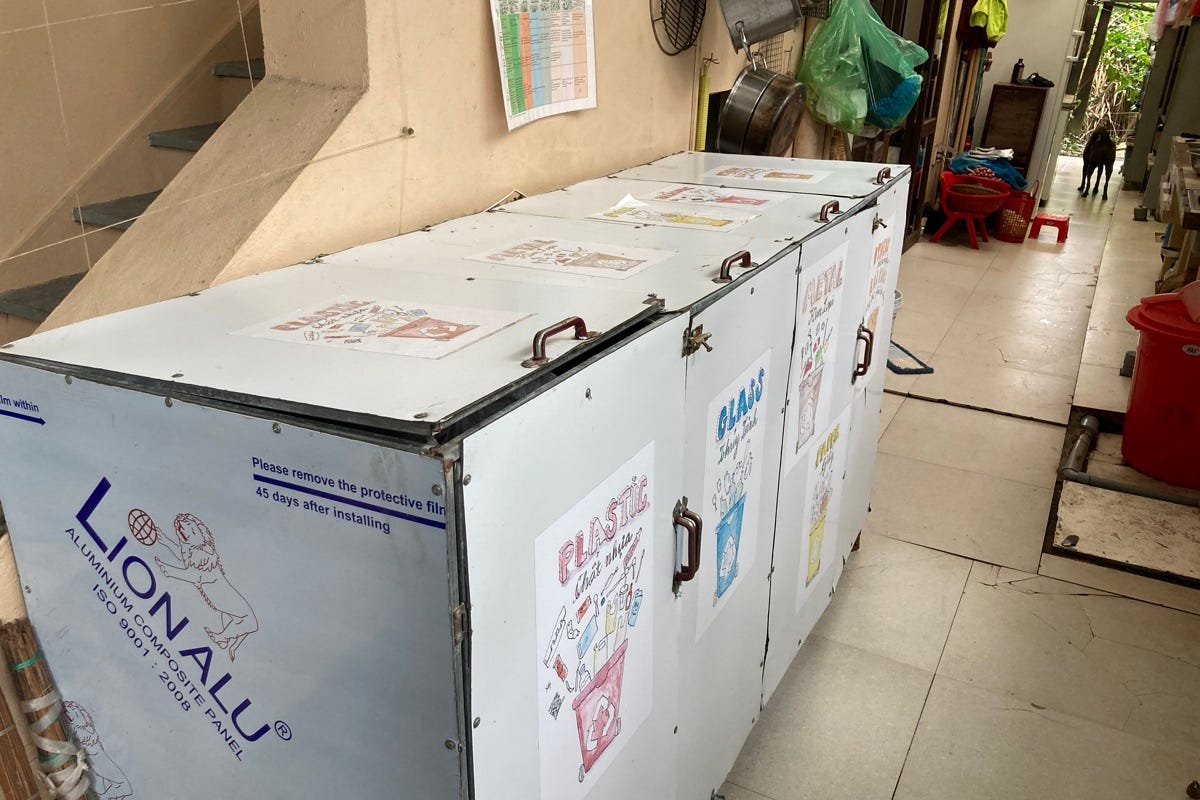A quick word of introduction—particularly to the five hundred odd new subscribers I seem to have picked up over the last week—thanks Substack Notes. My name is Stuart McDonald and this is Couchfish—the perfect tub of ice-cream for the traveller stranded on the couch. The newsletter has a paid edition which traces a fantasy itinerary through Southeast Asia, and a free edition that covers, well, everything else. You’re reading the latter here, but if you’d like to read the former, you can upgrade your subscription via the button below. Thanks!
Earlier this year I spent a few weeks in Vietnam travelling it tail to top. I wanted to see how things were picking up in these waning pandemic times, but I also had sustainable travel on my mind—was it possible in Vietnam? In this, the second part of a three-part series, I’m in the middle of the country thinking about hotels, hospitality and the environment. You can read the first part here.
Sorry for the radio silence over the last week—I came down with Covid.
Huế: Sustainability’s Many Hues
When it comes to beauty, there’s only one way to approach Vietnam’s once imperial capital—by train from the south. Leaving Đà Nẵng’s crass glass and brass towers behind, we crawl along one of Southeast Asia’s most beautiful stretches of railway. As the towers fade to the horizon, steep cliffs plunge into the sea by lonely crescents of sand. I lose phone coverage so there’s nothing to do but gaze, and the mostly local passengers step out of their couchettes to gaze beside me.
Even through a blurry train window you can tell the trip is pretty. Photo: Stuart McDonald.
My Huế hotel, Maison Vu Tri Vien is set down a back alley within the walled old city and when I finally find it, I wonder if it’s even open. The gate locked and nobody home, I’m on my phone double checking when a young boy lets me in … to the family home. Later, I’m chatting to owner Đức who gives me a potted history of the house. He tells me he was born inside, and it dates to 1969, a date I confirm three times as building a house within a year of the Battle of Huế would have been an interesting time to have been laying brick.
The house has nine rooms and while he closed for a stretch during the pandemic, he re-opened soon after Vietnam did. The mostly European clientele arrive courtesy of Booking and AirBnb and while Đức’s French is more polished than his English, he’s comfortable chatting with me as he sneaks a furtive cigarette out front. Business is good and he’s full for almost the entirety of my stay.
I’m in Huế for a conference, and on the final day, Nguyễn Văn Phúc, the Director of Hue Tourism gives a presentation. He discusses Huế developing itself as a “wellness destination,” something I’d never considered tying to the city. This is the second presentation along this theme, with Hylton Lipkin, the then GM of Alba Wellness, on a similar tack. The Director talks about the lucrative niche wellness represents, and of exploiting more of the hinterland’s springs. He’s focused of more—more resorts, more facilities, more tourists, more money—all the while dovetailing the surrounds’ natural beauty with Huế’s food and traditional medicines.
The kind of wellness I go to Huế for. Photo: Stuart McDonald.
To my mind, he’s missing the forest for the trees. As I wrote earlier, Huế’s strength is on its doorstep, its food and the old city. With little money and effort, that could be used to pry a day off of Hội An to see people spend another in Huế, putting money in the hands of small local-owned businesses. When the Director asks for questions, while I have many, I ask about this, but the answer is non-committal—he’s very much for building stuff—lots of stuff. Later, in a telephone conversation with Lipkin, we talk about Alba.
Lipkin is, in his own words, “obsessed” with the environment. He sees himself as a crusader but from the educative school rather than its sword-wielding cousin. He tells me about his efforts—and successes—in raising the awareness of his staff around sustainable practices. This isn’t just about tree planting, he tells me, rather it can be expressed through all facets of the business’ operations. He understands that running a resort the size of Alba along sustainable principles will save them money, but quips “It’s not about the price—it’s about saving the planet.”
When I say I’ve seen precious little in the way of sustainable behaviour at properties, and rail against tokenism like bamboo straws, Lipkin concurs. He notes that Vietnam—and Alba—has a ways to go. The resort has plans for solar, but they’re not there yet, and on tokenism, he compares sustainability to smoking, meaning as awareness grows, putting up “no smoking signs” becomes superfluous as people already know they can’t. So it should be with plastic straws, high energy lightbulbs and so on. The vast majority of guests at Alba are domestic and a typical stay is two to three days but if he can hook them into wellness packages, then that stay blows out to four or five days—that’s a win for slow travel.
Who doesn’t go to Huế for a Japanese-themed onsen? Photo: Stuart McDonald.
To my mind if you’re taking a sustainability view of travel, simple steps that could see people staying longer in Huế, and staying at small, locally-owned hotels is a win win. Hooking up your cart to a plan that calls for new developments in areas that are—for now—wilderness, not so much. With cautious eyes affixed to development driven disasters elsewhere in the country, you’d think there’d be some rethinking, yet for many in Vietnam, tourism remains a byproduct of property speculation. To look more into what development is bringing, I jump back on the train for a few hours and head south, to Đà Nẵng for Hội An.
Hội An: False Gold
Arguably Vietnam’s single most popular destination, Hội An is not my kind of place. I spend half a day out on its beach strip which only serves to cement my views—they’re an unadulterated mess. Back in town, the UNESCO Heritage listing protects its central “District 1” area, but thirty years of exploding tourism has wrought similar results as in Laos’ Luang Prabang. The town’s pretty lanterns and attractive shopfront architecture, daubed in its “colonial yellow” is photogenic, but the vibe is Disneyland. Tailors, cafes, restaurants, travel agents and bars line the heritage district—residences relegated to back lanes. Step out of District 1, and you’re back in Vietnam, with its life, street food, and incessant racket. Retreat the same twenty metres and you’re battling tour groups of thirty plus. It’s jarring, and not in a good way.
Some come for the lanterns. Photo: Stuart McDonald.
I came to Hội An in part to see a dog (long story), but thanks to Tết, the doggo is in Europe, so I’ve a couple of slack days. My digs are on the right track, but at the trailhead rather than the summit, and the track is lined with more hotels under construction—building is everywhere. In my room, there’s refillable water but the coffee is all disposables. What the manager describes to me as “sauna heated” water takes so long to arrive I give up. There’s also an instagram prop pretending to be a swimming pool. Staff on the other hand are excellent and the receptionist rains accolades upon management for how they handled staff through the pandemic. Like the town itself, on the sustainability front, the hotel is a mixed bag.
One morning I meet a tourism insider for a coffee at Espresso Station—the coffee shop pretty much everyone I speak to suggests we meet at. It’s set down a lane off Trần Hưng Đạo, which is to say it’s in Vietnam rather than UNESCO-land. What is supposed to be a thirty minute chat turns into two hours. We talk about the challenges Hội An faces—the building, the crowds, the rubbish—but more than anything we talk about Bà Nà Hills. If you were looking for a Central Vietnam version of sustainability hell-scape Phú Quốc, it qualifies—though the local administration prefers to invoke another mess of over-development, nominating it as “the Đà Lạt of Đà Nẵng province.”
Bà Nà’s heritage dates back to the French colonial period, when it was popularised as a highland getaway to escape the warmer coastal climate. Once the colonialists were booted out, their hillside hideout fell into disrepair and, for a short spell following the “reopening” of the country, it held appeal for exploring the ruins of French folly. That wasn’t though to last. In Vietnam, nature can always be improved, particularly if there is scope for a cable car.
Woman in blue: “What the hell am I doing here?” Photo: Stuart McDonald.
Gargantuan developer Sun World took a shine to the hills and reinvented it to the point the company’s name is now affixed to it. No doubt you’ve seen photos of the “Golden Hands” a 150 metre long viewpoint bridge held up by enormous hands. They’re at Bà Nà, sorry, I mean Sunworld Bà Nà, as is a Disneylandesque smorgasbord of contrived tourist-traps. When not submerged in mist, the viewpoint offers up indeed golden views (I’m being generous here in assuming the golden refers to the view and not the income it earns Sun World), but the views—from what was national park land—didn’t come for free from all involved.
In a great piece on Vietnam’s seeming addiction to cable cars, journalist Govi Snell quotes “concerned citizen,” Bùi Huyền Trang on who really paid the ultimate price for the development:
“More than 60 hectares [148 acres] of forest were flattened,” she stated. “In the past, Nui Chua was very poetic, stretching forests and diverse birds and animals, especially the famous indigenous langur. But after the forests were tragically cut down, the animals’ habitats were reduced and gradually they no longer appeared.”
The Golden Hands feature in just about every Insta-whatever list for Vietnam, but good luck trying to find stories about their environmental impact. While Sun World doesn’t even bother pretending that anything to do with Bà Nà is sustainable, you routinely see it profiled in both domestic and international pieces purporting to suggest it somehow is. It isn’t.
Hội An: Real Gold
There’s a divergence between what I think “eco” means and what Vietnam does. In Vietnam sinh thái—which roughly translates as “ecological”—is often affixed to resorts that are in a natural setting. This, in turn often gets translated into “ecolodge” or “eco resort” in English, which, well, means something a bit different. Exploring this, and looking to find a “new Hội An,” I hire a local guide and a motorbike and hit the road.
The path to the ancient house be slippery. Photo: Stuart McDonald.
An hour or so inland from Hội An lie three districts, Hiệp Đức, Tiên Phước, and below them, Phú Ninh, with Hồ Phú Ninh, an artificial lake that is a supposed eco-zone, at its centre. The plan is to visit some “historical houses” in the first two areas then visit the lake. I discuss the plan with my guide Tran, who harks from the area. He’s optimistic—despite the filthy weather.
We stick to back roads and it doesn’t take long to leave Hội An behind us. This is the scenery and vibe that has made the country such a great one for motorbike touring, the scenery ratcheting up as the roads narrow. What I’m hoping for is to find enough to fill a couple of days in order to give people a reason to strike further afield than Hội An. As things pan out though, the planned two days folds back into one.
Some of the houses are closed, another we can’t find, a third, according to an old woman by the side of the road, washed away in a storm. Signposting is limited, and when we do reach an open house—approached by the slipperiest goddam footpath in the country—it only heightens the disappointment in the others being closed. Surviving the footpath, we interrupt a resident busying himself on a laptop at Huỳnh Thúc Kháng and he packs up to get out of sight. Much like the historic houses in Hội An it is pretty and interesting, and unlike its better known relatives, it feels more living than a museum. As we leave, the laptop guy empties a flooded flower pot onto the footpath covering its slime with a new coating. I don’t think it was personal.
Vietnam: Honest food and honest smiles. Photo: Stuart McDonald.
We cut our losses on the old house front and keen to see the eco-tourism lake, we bike down to Hồ Phú Ninh. Much of the lakeside forest we ride through is working forest, eucalypt, making for a scene that is more striking and sterile than pretty. We reach a pre-lunch stop and relaxing in plastic chairs by the water’s edge is well pretty—the menu though is heavy of unsustainable bush food and I’m later told the premises are a favourite among officials wanting to do deals out of sight—it feels like that kind of joint.
It is Tết and as we’ve a lunch appointment with Tran’s family, we pass up on the chance for a bush food banquet and leave, riding up the other side of the lake. The beauty goes up a level, as the forest is not commercial and has that wild feel I’d been hoping for. Looking back at the shimmering blue green hillsides of eucalypt, change is closer than the horizon.
Tran’s family home is a simple affair—a single floor house opening out onto a yard down more lefts and rights than I care to remember. The spread is already on the way, and I sit with his father, sister and two nieces while the last of the barbecuing is finished off. His father’s English is as solid as my Vietnamese so we smile and nod and drink plenty of tea. His sister though has good English and she gives me the family history. She lives in the south, just outside Hồ Chí Minh City where she works in the garment industry, but she’s back for Tết and her parents are clearly enjoying having their grand daughter back on their turf. We make small talk as the food arrives—entire chickens, dipping sauces, rice, iced beers, and plate after plate of grilled pork. I like my pork, but there is only so much one can eat, and I feign defeat far earlier than Tran.
Sixty-two kilos of pork later. Photo: Tran’s sister (whose name I forget, sorry!)
It’s a welcome interlude to the riding, and while I feel like I’m intruding on what is a family day, they wouldn’t have it any other way. This is the hospitality Vietnam is so famous for—I do feel like we’re re-meeting rather than meeting for the first time. As lunch winds down we take some group photos, a niece posing cheekily—by design I think as her posing necessitates even more photos.
Our last stop takes us back to the lake, to an “eco resort” that is anything but. I’d been warned beforehand to not show up with high expectations, but it sums up the disconnect in my mind. It’s “green” in that there is some forest around it, but the actual establishment—instaprops and all—is anything but. Rooms are free-standing chalets perched along ridges running down to the water, and sure it could be worse—it could be a Sun World property—but there’s nothing environmental nor sustainable to it. Not long after we leave, a friend in Hội An messages me to ask if I saw the statue of the prehistoric man the hotel has. I’m sad I missed it, but not sad enough to return.
On the ride back I opt for the gun barrel highway that runs from Tam Kỳ’s coastal strip north to Hội An. It’s a great road, double carriage nearly the entire way, lined with what must be thousands of palm trees. A little shy of the river I reach Vin Wonders Nam Hoi An—between the road and the beach it houses a waterpark, golf course, river safari park, and accommodation. At roughly a kilometre wide and two deep, it is developments like exactly this that have contributed so much damage to destinations like Phú Quốc, and yet there’s no end in sight.
Hội An: Nuggets Of Gold
My last morning in Hội An is very much a case of saving the best till last. I spend an hour chatting to Tam, one of the four owners at An Villa, a small boutique hotel that is walking the talk—and that is everything Vin Wonders isn’t.
An Villa’s great work extends to their food. Photo: Stuart McDonald.
It’s a small hotel, with cottage-style rooms clustered around a freeform swimming pool with a restaurant on the near side. Tam busies herself farewelling what look to be some very satisfied guests, then walks me through the property explaining what they’re doing and why. Our conversation is a breath of fresh air, and she embodies the mindset of doing something the right way because you wouldn’t think to do it any other.
At one stage we’re out back and she’s explaining their waste sorting. They compost what they can, then all else is split out into recycling and so on, with large colour-coded bins making it as simple as possible. I ask if the approach saved them money and she looks at me like I’m an idiot for asking before smiling and explaining that taking just this step reduced their rubbish collection costs by seventy per cent.
Later, in one of the rooms, I’m getting the spiel on no single use plastic—unlike another Hội An property I stayed in that had over thirty pieces in my room—and, on the bathroom counter I see a little glass jar full of what to be honest I first think are ecstasy tablets. Tam tells me the pills are dentabs—an alternative to toothpaste—you just pop one in your mouth, chew it, add water and brush. It seems like the smallest of things, but I can’t remember the last time I walked down a beach in Bali and didn’t see a discarded toothpaste tube.
Simple steps make all the difference. Photo: Stuart McDonald.
As a property owner, it must feel like the biggest waste of time concentrating on swapping out toothpaste tubes for lookalike ecstasy while 15 minutes away Vinwhatever is doing everything except burning fluffy bunnies for electricity. And yet, Tam is so matter of fact about it—they’re doing what they do because it is the right way to do things—and it is saving them money in the process.
On the drive back to Đà Nẵng for my train north, I pass by a series of colossal hotels going in between the road and the beach. The water is so close I can see it between the towers, and yet they’re going in what must be metres from the high water mark. It isn’t just local hotels—many of the international chains are represented. You know, the companies who are forever carrying on about how sustainable they are, managing eyesore towers that most likely would not be permitted in their home country. Their hypocrisy and greenwashing grandstanding makes me sick.
Talking about feeling sick, thirty minutes later I’m chewing through an overpriced bánh mì at Đà Nẵng train station, and I think about Tam with her dentabs, and Tết lunch with Tran’s family—small hospitable operators trying to do the right thing—while just up the road an international wrecking ball is totalling the joint.
Couchfish is 100 per cent independent and reader-supported. If you’re not already a subscriber, and you’d like to show your support, become a paying subscriber today for just US$7 per month—you can find out more about Couchfish here—or simply share this story with a friend.
Don’t forget, you can find the free podcasts on Apple, Pocket Casts and Spotify as well as right here on Couchfish.






















Share this post